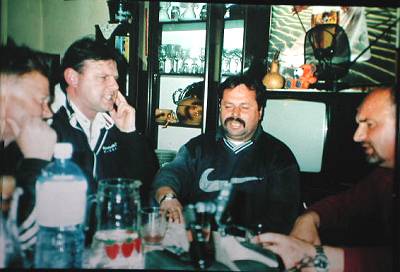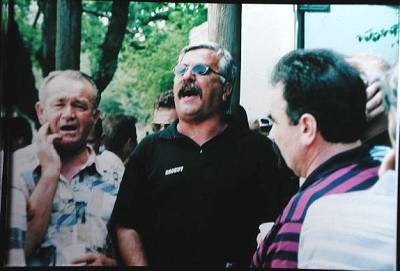The only repertoire of old times which has persisted
is guslarske pjesme (10).
The guslari are still "famous" in their
local communities, especially appreciated for their art
of music making, singing and improvising new lyrics in a
new situation (kontanje).
It is interesting that the stereotype of a gusle player - an old grey-haired man with a big mustache - is changing in practice. There is an increasing number of young people who take on singing and gusle playing.
Some of my informants (Ante Juric, Zlatko Stupalo) link their beginnings with the beginning of the Homeland War, (11) which has initiated them as gusle players. The topics of contemporary guslarske pjesme are primarily the recent Homeland War and contemporary political issues, but also the "emancipation" of women (women liberation), natality and other current problems of the society we live in and the society the guslari are performing for. The guslari are welcome guests in all local and regional manifestations, but also as entertainers for their friends za kominom [by the fireplace] or for the neighbours who enjoy listening to them.
The three dominant vocal genres in today's practice - ganga, rera and ojkavica (oja-noja) are the most attractive and the most frequently performed forms. The information gathered from literature (Bezic's, Buble's and Petrovic's works) mention these genres as phenomena which appeared in relatively recent history - at the beginning of the 20th century. All three ways of singing are polyphonic forms, in which usually participate 2 to 4 singers, one of which goni, konta - leads the song and performs the lyrics syllabically, while the rest back him/her up by unison singing (gangati, rerati, ojkati). The second part of the form is always performed in polyphonic progression with the characteristic ending of major seconds, experienced by them as consonant. All three genres are textually conceived as a decasyllabic couplet which contents the preferred context of a short closed form and is the most probable cause of their exceptional popularity. This is an authentic and the most vital musical expression which is not abandoned under any circumstances, even when moving to towns (Petrovic, 1978:16). By comparing the audio recordings from the mid 20th century onwards we can notice that the way of singing has remained more or less the same, as opposed to the lyrics, which always aim to be contemporary (the war, politics, emigration), amatory or vulgarly erotic. I will illustrate this with my own experience. Only a few months after the Croatian presidential elections in year 2000, in the surroundings of Sinj I had the opportunity to hear the rera.
The current lyrics state an apparent dissatisfaction of the local people with the public appearances of the new president Stjepan Mesic, who has taken the place of - in their view - the charismatic founder of the Croatian state, Franjo Tudjman. In the following several months I had the opportunity to hear the same lyrics performed by various singing groups, from Dalmatia and from the neighboring Bosnia-Herzegovina. In the past, singing was traditional way to express political stands and opinions. Present democratic system allows them to sing it freely without punishment (prison sentence) as it was historical fact in past political systems (12). The erotic lyrics performed by male singers are usually openly harsh and vulgar, while female lyrics tend to send the message metaphorically. Within all three genres there are several different forms which sound the same to a person outside the tradition. On the other hand, the singers and the listeners who come from the tradition are able to differentiate between certain forms and style characteristics, using their own terminology. Knowing the genres and the forms is proportionate to the range of their social contacts and movement. They know the best the forms they practice themselves, and then the ones adjoining the area of their expertise. Today's communication which enables easy moving around, leads to disappearance of certain forms for several reasons. Singing is no longer a local practice but a practice accessible to a wider audience. The singers that have been organized according to their belonging to a family, a tribe or a village prefer singing with persons from other areas whose vocal possibilities and social status suits them better. In a new situation usually the common, the most similar but also the most attractive part of the repertoire is chosen, while the less attractive part is slowly being forgotten. Groups are not recognized by their name, what, for example, is the practice with the coastal klapa singing, but for their dominant singer (e.g. Kokan's klapa) or from the area they come from (e.g. Sinjani, Dicmljani [from Sinj, from Dicmo]). For the singers which sing in such semiformal singing groups the term professionals is used, and it denotes skilled, good singers, and not the singers who are paid for their singing. Although the tastes change, due to the media unexposure of this kind of musical practice, the term popular in the western sense has not yet been accepted. |

